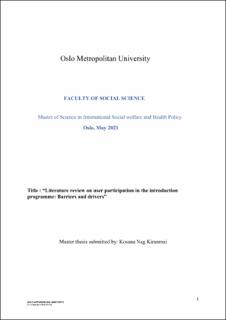| dc.description.abstract | My thesis is a part of a larger project which is titled as “CHAPAR” project. The primary objective of the project is to develop knowledge that will contribute towards active user participation in the Introduction program in Norway. The aim of the thesis is to identify the barriers and drivers faced by the Refugees and Immigrants while participating in the Introduction Program in Norway. Few substantial findings have been illustrated through this study which gives an overview on the current barriers and drivers faced by the users while going through the Program training period. The study carried out a literature review on the relevant available literature. The Young refugees with a minority background, little or no education are the most vulnerable group in the labor markets (Havneras, 2016).The Introduction Program is introduced to strengthen the relationship between target group and labor market by directing them towards the integration process. Participation in the program is mandatory and user influence might be difficult to attain. Many studies reveal that Language is an important barrier which influence user participation in program and settlement in the society. There are only few studies available which have focused on user’s participation in the Introduction Program (Djuve & Kavli, 2015) (Djuve, Kavli, Braanen sterri & Braten, 2017).
Through my study I focus on the identified barriers and drivers of user participation in Introduction program from the literature review which are illustrated below.
1. Individual plan based on the user background and in collaboration with them is identified as a driver of user participation from user perspective. The individual plan drawn in the form of symbols and images instead of texts are considered as drivers of user participation.
2. Lack of tailoring the programme according to individual needs and desires may lead to less motivation at individual level and seen as barrier of participation from case worker perspective.
3. Users must be heard and be able to take self-decisions which may increase the possibility of user involvement and can promote user participation.
4. Poor language training (less grammar) and unidentified user competence are considered as barriers of participation by user perspective.
5. Service users with personal circumstances such as chronic sickness, larger households and financial responsibilities are identified as barriers towards participation during the program.
6. Caseworkers providing complete guidance and a systematic follow up to the service users is an identified driver of participation during the program.
7. The introduction programme has two known components that is financial and education. The third component which is called as mental component is less acknowledge and identified as a barrier for user participation from user perspective.
8. Gender is playing a role of barrier for women and driver for men while participating in the program.
9. Language is barrier from user perspective and driver from case worker perspective for participation in the program. | en_US |
